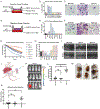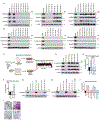Single-Chromosomal Gains Can Function as Metastasis Suppressors and Promoters in Colon Cancer
- PMID: 32097652
- PMCID: PMC7354079
- DOI: 10.1016/j.devcel.2020.01.034
Single-Chromosomal Gains Can Function as Metastasis Suppressors and Promoters in Colon Cancer
Abstract
High levels of cancer aneuploidy are frequently associated with poor prognosis. To examine the relationship between aneuploidy and cancer progression, we analyzed a series of congenic cell lines that harbor single extra chromosomes. We found that across 13 different trisomic cell lines, 12 trisomies suppressed invasiveness or were largely neutral, while a single trisomy increased metastatic behavior by triggering a partial epithelial-mesenchymal transition. In contrast, we discovered that chromosomal instability activates cGAS/STING signaling but strongly suppresses invasiveness. By analyzing patient copy-number data, we demonstrate that specific aneuploidies are associated with distinct outcomes, and the acquisition of certain aneuploidies is in fact linked with a favorable prognosis. Thus, aneuploidy is not a uniform driver of malignancy, and different aneuploidies can uniquely influence tumor progression. At the same time, the gain of a single chromosome is capable of inducing a profound cell state transition, thereby linking genomic plasticity, phenotypic plasticity, and metastasis.
Keywords: EMT; aneuploidy; cGAS/STING; chromosome missegregation; copy number variation; metastasis.
Copyright © 2020 Elsevier Inc. All rights reserved.
Conflict of interest statement
Declaration of Interests J.M.S. has received consulting fees from Ono Pharmaceutical Co. and is a member of the Advisory Board of Tyra Biosciences.
Figures







Comment in
-
Weighing up effects of extra chromosomes.Nat Rev Cancer. 2020 May;20(5):259. doi: 10.1038/s41568-020-0257-y. Nat Rev Cancer. 2020. PMID: 32235903 No abstract available.
References
-
- Andrews P 2017. MUMdex Software. MUMdex Genome Alignment Anal Softw. https://mumdex.com/ (Accessed February 27, 2019).
-
- Andrews PA, Iossifov I, Kendall J, Marks S, Muthuswamy L, Wang Z, Levy D, Wigler M. 2016. MUMdex: MUM-based structural variation detection. bioRxiv 078261.
Publication types
MeSH terms
Substances
Grants and funding
LinkOut - more resources
Full Text Sources
Research Materials

